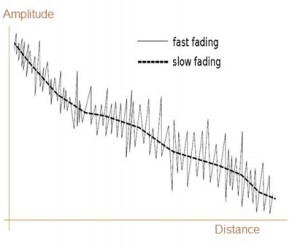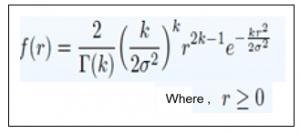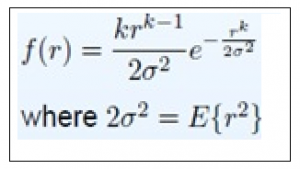This page describes Fading basics and types of fading in wireless communication. The Fading types are divided into large scale fading and small scale fading (multipath delay spread and doppler spread).
Flat fading and frequency selecting fading are part of multipath fading where as fast fading and slow fading are part of doppler spread fading. These fading types are implemented as per Rayleigh, Rician, Nakagami and Weibull distributions or models.
Introduction:
As we know wireless communication system consists of transmitter and receiver. The path from transmitter to the receiver is not smooth and the transmitted signal may go through various kinds of attenuations including path loss, multipath attenuation etc. The signal attenuation through the path depends on various factors. They are time, radio frequency and path or position of transmitter/receiver. The channel between transmitter and receiver can be time varying or fixed depending upon whether the transmitter/receiver are fixed or moving with respect to each other.
What is fading?
The time variation of received signal power due to changes in transmission medium or paths is known as fading. Fading depends on various factors as mentioned above. In fixed scenario, fading depends on atmospheric conditions such as rainfall, lightening etc. In mobile scenario, fading depends on obstacles over the path which are varying with respect to time. These obstacles create complex transmission effects to the transmitted signal.

The figure-1 depicts amplitude versus distance chart for slow fading and fast fading types which we will discuss later.
Fading types

Considering various channel related impairments and position of transmitter/receiver following are the types of fading in wireless communication system.
➤Large Scale Fading: It includes path loss and shadowing effects.
➤Small Scale Fading: It is divided into two main categories viz. multipath delay spread and doppler spread. The multipath delay spread is further divided into flat fading and frequency selective fading. Doppler spread is divided into fast fading and slow fading.
➤Fading models: Above fading types are implemented in various models or distributions which include Rayleigh, Rician, Nakagami, Weibull etc.
As we know, fading signals occur due to reflections from ground and surrounding buildings as as well as scattered signals from trees, people and towers present in the large area. There are two types of fading viz. large scale fading and small scale fading.
1.) Large Scale Fading
Large scale fading occurs when an obstacle comes in between transmitter and receiver. This interference type causes significant amount of signal strength reduction. This is because EM wave is shadowed or blocked by the obstacle. It is related to large fluctuations of the signal over distance.
1.a) Path loss
The free space path loss can be expressed as follows.
➤ Pt/Pr = {(4 * π * d)2/ λ2} = (4*π*f*d)2/c2
Where,
Pt = Transmit power
Pr = Receive power
λ = wavelength
d = distance between transmitting and receiving antenna
c = speed of light i.e. 3 x 108
From the equation it implies that transmitted signal attenuates over distance as the signal is being spread over larger and larger area from transmit end towards receive end.
1.b) Shadowing effect
• It is observed in wireless communication. Shadowing is deviation of received power of EM signal from average value.
• It is result of obstacles over the path between transmitter and receiver.
• It depends on geographical position as well as radio frequency of EM (ElectroMagnetic) waves.
2. Small Scale Fading
Small scale fading is concerned with rapid fluctuations of received signal strength over very short distance and short time period.
Based on multipath delay spread there are two types of small scale fading viz. flat fading and frequency selective fading. These multipath fading types depend on propagation environment.
2.a) Flat fading
The wireless channel is said to be flat fading if it has constant gain and linear phase response over a bandwidth which is greater than the bandwidth of the transmitted signal.
In this type of fading all the frequency components of the received signal fluctuate in same proportions simultaneously. It is also known as non-selective fading.
• Signal BW << Channel BW
• Symbol period >> Delay Spread
The effect of flat fading is seen as decrease in SNR. These flat fading channels are known as amplitude varying channels or narrowband channels.
2.b) Frequency Selective fading
It affects different spectral components of a radio signal with different amplitudes. Hence the name selective fading.
• Signal BW > Channel BW
• Symbol period < Delay Spread
Based on doppler spread there are two types of fading viz. fast fading and slow fading. These doppler spread fading types depend on mobile speed i.e. speed of receiver with respect to transmitter.
2.c) Fast fading
The phenomenon of fast fading is represented by rapid fluctuations of signal over small areas (i.e. bandwidth). When the signals arrive from all the directions in the plane, fast fading will be observed for all directions of motion.
Fast fading occurs when channel impulse response changes very rapidly within the symbol duration.
• High doppler spread
• Symbol period > Coherence time
• Signal Variation < Channel variation
This parameters result into frequency dispersion or time selective fading due to doppler spreading. Fast fading is result of reflections of local objects and motion of objects relative to those objects.
In fast fading, receive signal is sum of numerous signals which are reflected from various surfaces. This signal is sum or difference of multiple signals which can be constructive or destructive based on relative phase shift between them. Phase relationships depend on speed of motion, frequency of transmission and relative path lengths.
Fast fading distorts the shape of the baseband pulse. This distortion is linear and creates ISI (Inter Symbol Interference). Adaptive equalization reduces ISI by removing linear distortion induced by channel.
2.d) Slow fading
Slow fading is result of shadowing by buildings, hills, mountains and other objects over the path.
• Low Doppler Spread
• Symbol period <<Coherence Time
• Signal Variation >> Channel Variation
Implementation of Fading models or fading distributions
Implementations of fading models or fading distributions include Rayleigh fading, Rician fading, Nakagami fading and Weibull fading. These channel distributions or models are designed to incorporate fading in the baseband data signal as per fading profile requirements.
Rayleigh fading
• In Rayleigh model, only Non Line of Sight(NLOS) components are simulated between transmitter and receiver. It is assumed that there is no LOS path exists between transmitter and receiver.
• MATLAB provides "rayleighchan" function to simulate rayleigh channel model.
• The power is exponentially distributed.
• The phase is uniformly distributed and independent from the amplitude. It is the most used types of Fading in wireless communication.
Rician fading
• In rician model, both Line of Sight (LOS) and non Line of Sight(NLOS) components are simulated between transmitter and receiver.
• MATLAB provides "ricianchan" function to simulate rician channel model.
Nakagami fading
Nakagami fadding channel is a statistical model used to describe wireless communication channels in which the received sgnal undergoes multipath fading. It represents environments with moderate to severe fading such as urban or suburban areas. The following equation can be used to simulate Nakagami fading channel model.

• In this case we denote h = r*ejΦ and angle Φ is uniformly distributed on [-π, π]
• The variable r and Φ are assumed to be mutually independent.
• The Nakagami pdf is expressed as above.
• In the Nakagami pdf, 2σ2 = E{r2}, Γ(.) is the Gamma function and k >= (1/2) is the fading figure (degrees of freedom related to the number of added Gaussion random variables).
• It was originally developed empirically based on measurements.
• Instantaneous receive power is Gamma distributed. • With k = 1 Rayleigh = Nakagami
Weibull fading
This channel is another statistical model used to describe wireless communication channel. Weibull fading channel is commonly used to represent environments with various types of fading conditions including both weak and severe fading.

Where,
2σ2 = E{r2}
• Weibull distribution represents another generalization of the Rayleigh distribution.
• When X and Y are i.i.d. zero mean gaussian variables, the envelope of R = (X2 + Y2)1/2 is Rayleigh distributed. • However envelope is defined R = (X2 + Y2)1/2, and the corresponding pdf (power distribution profile) is Weibull distributed.
• The following equation can be used to simulate Weibull fading model.
In this page we have gone through various topics on fading such as what is fading channel, its types, fading models, their applications, functions and so on. One can use the information provided on this page in order to compare and derive difference between small scale fading and large scale fading, difference between flat fading and frequency selective fading, difference between fast fading and slow fading, difference between rayleigh fading and rician fading and so on.
E-mail:info@rf-miso.com
Phone:0086-028-82695327
Website:www.rf-miso.com
Post time: Aug-14-2023







